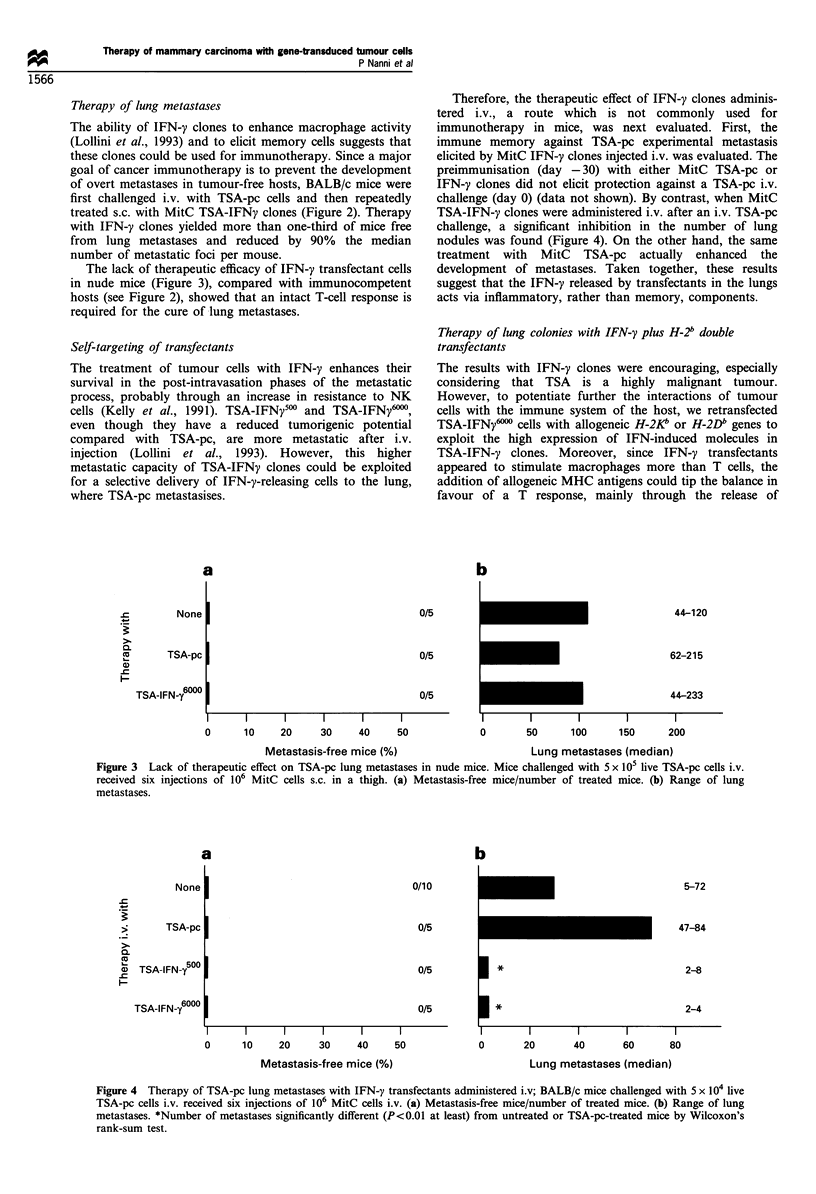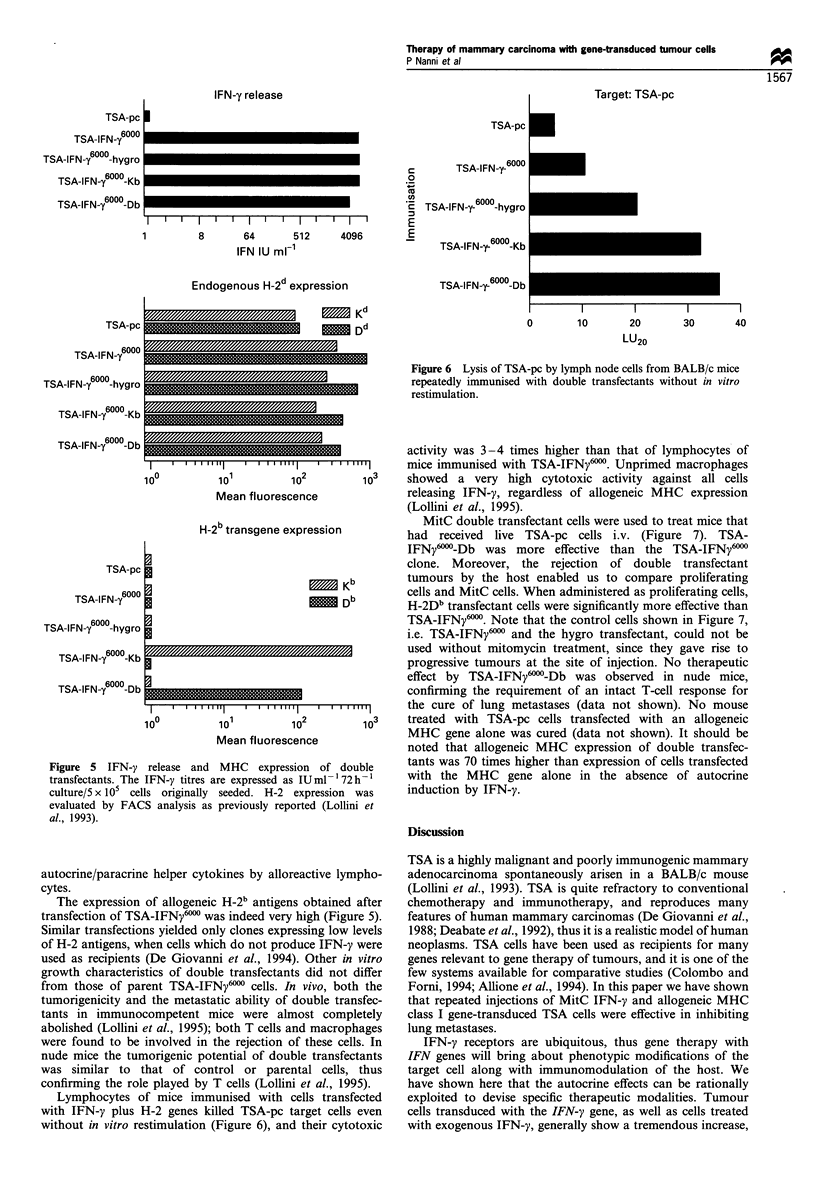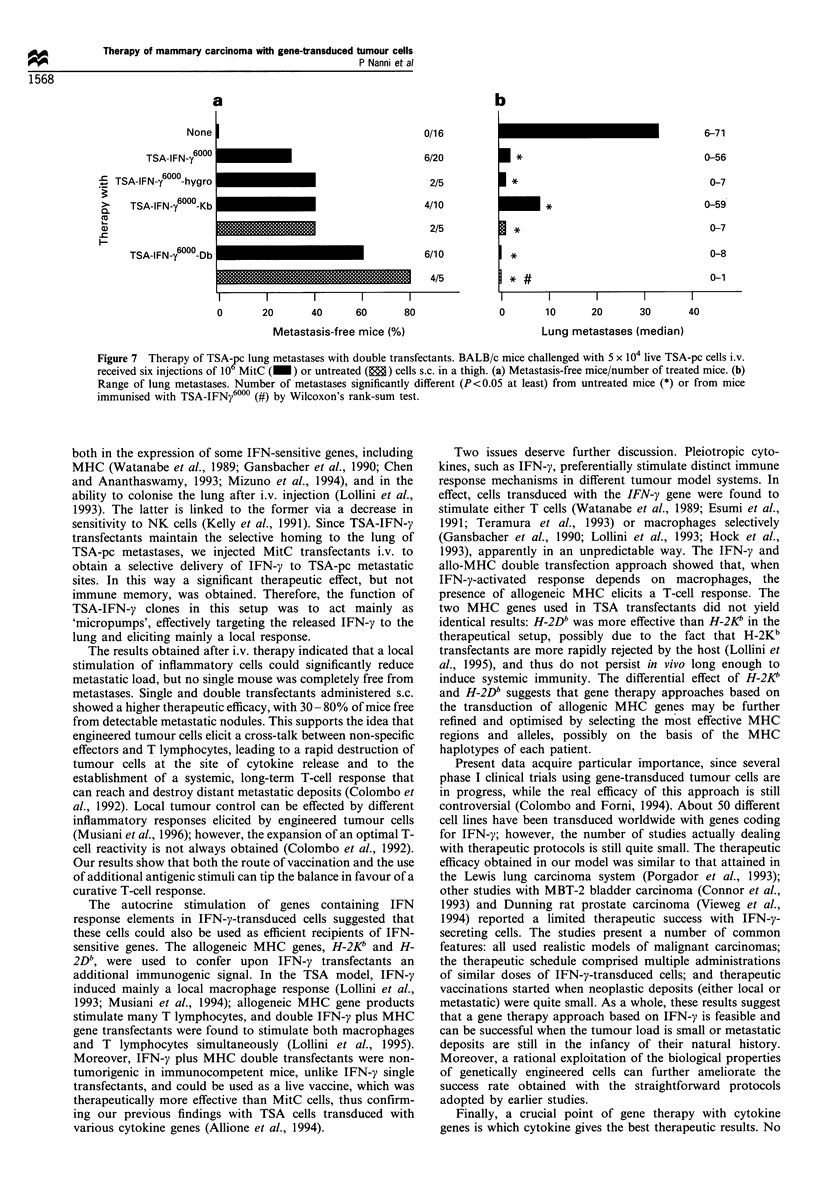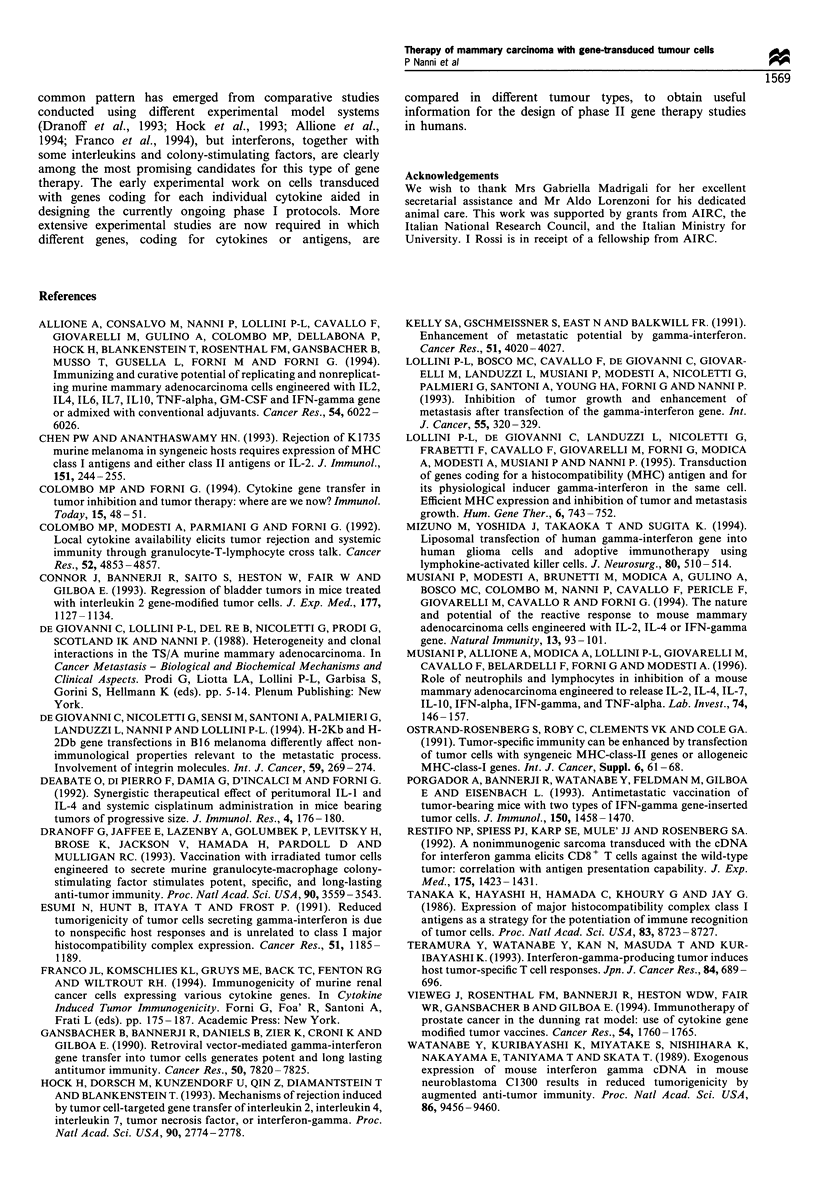Abstract
Gene-transfected tumour cells were used to cure mice bearing lung metastases by the parental, non-transduced mammary adenocarcinoma (TSA-pc). Repeated subcutaneous (s.c.) administrations of mitomycin C (MitC)-treated interferon gamma (IFN-gamma) transfectants induced a 90% inhibition in the number of lung metastases. Therapeutic effect required an intact T-cell response, as shown by the lack of efficacy in nude mice. Autocrine stimulation by IFN-gamma induces specific modifications in the phenotype of transfectants that acquire a high metastatic ability and show a high expression of IFN-responsive genes; these two features were exploited to design two experimental protocols to obtain an improvement of the therapeutic effect. The increased metastatic ability of IFN-gamma transfectants was used to deliver IFN-gamma selectively to the lungs of mice bearing TSA-pc pulmonary metastases. A significant therapeutic effect was obtained when TSA-pc experimental metastases were treated by repeated intravenous (i.v.) injections of MitC IFN-gamma transfectants. Since i.v. administrations of IFN-gamma transfectants did not induce immune memory, the therapeutical effect appeared to depend on the inflammatory-like response activated by local IFN release. To exploit the autocrine stimulation of IFN-sensitive genes an IFN-gamma transfectant clone was subjected to a second transfection with an allogeneic class I MHC gene (H-2K(b) or H-2D(h)). IFN-gamma plus MHC double transfectants maintained IFN-gamma release, showed a very high expression of the MHC gene products, stimulated both macrophages and T cells, and were less tumorigenic in immunocompetent mice than the parent IFN-gamma clone. Therapeutic efficacy of double transfectant IFN-gamma plus H-2D(b) cells against TSA-pc was superior to single transfectants, showing that the reaction elicited by genetically engineered cells can be selectively tuned to increase therapeutic efficacy.
Full text
PDF





Selected References
These references are in PubMed. This may not be the complete list of references from this article.
- Allione A., Consalvo M., Nanni P., Lollini P. L., Cavallo F., Giovarelli M., Forni M., Gulino A., Colombo M. P., Dellabona P. Immunizing and curative potential of replicating and nonreplicating murine mammary adenocarcinoma cells engineered with interleukin (IL)-2, IL-4, IL-6, IL-7, IL-10, tumor necrosis factor alpha, granulocyte-macrophage colony-stimulating factor, and gamma-interferon gene or admixed with conventional adjuvants. Cancer Res. 1994 Dec 1;54(23):6022–6026. [PubMed] [Google Scholar]
- Chen P. W., Ananthaswamy H. N. Rejection of K1735 murine melanoma in syngeneic hosts requires expression of MHC class I antigens and either class II antigens or IL-2. J Immunol. 1993 Jul 1;151(1):244–255. [PubMed] [Google Scholar]
- Colombo M. P., Forni G. Cytokine gene transfer in tumor inhibition and tumor therapy: where are we now? Immunol Today. 1994 Feb;15(2):48–51. doi: 10.1016/0167-5699(94)90131-7. [DOI] [PubMed] [Google Scholar]
- Colombo M. P., Modesti A., Parmiani G., Forni G. Local cytokine availability elicits tumor rejection and systemic immunity through granulocyte-T-lymphocyte cross-talk. Cancer Res. 1992 Sep 15;52(18):4853–4857. [PubMed] [Google Scholar]
- Connor J., Bannerji R., Saito S., Heston W., Fair W., Gilboa E. Regression of bladder tumors in mice treated with interleukin 2 gene-modified tumor cells. J Exp Med. 1993 Apr 1;177(4):1127–1134. doi: 10.1084/jem.177.4.1127. [DOI] [PMC free article] [PubMed] [Google Scholar]
- De Giovanni C., Lollini P. L., Del Re B., Nicoletti G., Prodi G., Scotlandi K., Nanni P. Heterogeneity and clonal interactions in the TS/A murine mammary adenocarcinoma. Adv Exp Med Biol. 1988;233:5–14. doi: 10.1007/978-1-4899-5037-6_2. [DOI] [PubMed] [Google Scholar]
- De Giovanni C., Nicoletti G., Sensi M., Santoni A., Palmieri G., Landuzzi L., Nanni P., Lollini P. L. H-2Kb and H-2Db gene transfections in B16 melanoma differently affect non-immunological properties relevant to the metastatic process. Involvement of integrin molecules. Int J Cancer. 1994 Oct 15;59(2):269–274. doi: 10.1002/ijc.2910590220. [DOI] [PubMed] [Google Scholar]
- Dranoff G., Jaffee E., Lazenby A., Golumbek P., Levitsky H., Brose K., Jackson V., Hamada H., Pardoll D., Mulligan R. C. Vaccination with irradiated tumor cells engineered to secrete murine granulocyte-macrophage colony-stimulating factor stimulates potent, specific, and long-lasting anti-tumor immunity. Proc Natl Acad Sci U S A. 1993 Apr 15;90(8):3539–3543. doi: 10.1073/pnas.90.8.3539. [DOI] [PMC free article] [PubMed] [Google Scholar]
- Esumi N., Hunt B., Itaya T., Frost P. Reduced tumorigenicity of murine tumor cells secreting gamma-interferon is due to nonspecific host responses and is unrelated to class I major histocompatibility complex expression. Cancer Res. 1991 Feb 15;51(4):1185–1189. [PubMed] [Google Scholar]
- Gansbacher B., Bannerji R., Daniels B., Zier K., Cronin K., Gilboa E. Retroviral vector-mediated gamma-interferon gene transfer into tumor cells generates potent and long lasting antitumor immunity. Cancer Res. 1990 Dec 15;50(24):7820–7825. [PubMed] [Google Scholar]
- Hock H., Dorsch M., Kunzendorf U., Qin Z., Diamantstein T., Blankenstein T. Mechanisms of rejection induced by tumor cell-targeted gene transfer of interleukin 2, interleukin 4, interleukin 7, tumor necrosis factor, or interferon gamma. Proc Natl Acad Sci U S A. 1993 Apr 1;90(7):2774–2778. doi: 10.1073/pnas.90.7.2774. [DOI] [PMC free article] [PubMed] [Google Scholar]
- Kelly S. A., Gschmeissner S., East N., Balkwill F. R. Enhancement of metastatic potential by gamma-interferon. Cancer Res. 1991 Aug 1;51(15):4020–4027. [PubMed] [Google Scholar]
- Lollini P. L., Bosco M. C., Cavallo F., De Giovanni C., Giovarelli M., Landuzzi L., Musiani P., Modesti A., Nicoletti G., Palmieri G. Inhibition of tumor growth and enhancement of metastasis after transfection of the gamma-interferon gene. Int J Cancer. 1993 Sep 9;55(2):320–329. doi: 10.1002/ijc.2910550224. [DOI] [PubMed] [Google Scholar]
- Lollini P. L., De Giovanni C., Landuzzi L., Nicoletti G., Frabetti F., Cavallo F., Giovarelli M., Forni G., Modica A., Modesti A. Transduction of genes coding for a histocompatibility (MHC) antigen and for its physiological inducer interferon-gamma in the same cell: efficient MHC expression and inhibition of tumor and metastasis growth. Hum Gene Ther. 1995 Jun;6(6):743–752. doi: 10.1089/hum.1995.6.6-743. [DOI] [PubMed] [Google Scholar]
- Mizuno M., Yoshida J., Takaoka T., Sugita K. Liposomal transfection of human gamma-interferon gene into human glioma cells and adoptive immunotherapy using lymphokine-activated killer cells. J Neurosurg. 1994 Mar;80(3):510–514. doi: 10.3171/jns.1994.80.3.0510. [DOI] [PubMed] [Google Scholar]
- Musiani P., Allione A., Modica A., Lollini P. L., Giovarelli M., Cavallo F., Belardelli F., Forni G., Modesti A. Role of neutrophils and lymphocytes in inhibition of a mouse mammary adenocarcinoma engineered to release IL-2, IL-4, IL-7, IL-10, IFN-alpha, IFN-gamma, and TNF-alpha. Lab Invest. 1996 Jan;74(1):146–157. [PubMed] [Google Scholar]
- Musiani P., Modesti A., Brunetti M., Modica A., Vitullo P., Gulino A., Bosco M. C., Colombo M. P., Nanni P., Cavallo F. Nature and potential of the reactive response to mouse mammary adenocarcinoma cells engineered with interleukin-2, interleukin-4 or interferon-gamma genes. Nat Immun. 1994 Mar-Jun;13(2-3):93–101. [PubMed] [Google Scholar]
- Ostrand-Rosenberg S., Roby C., Clements V. K., Cole G. A. Tumor-specific immunity can be enhanced by transfection of tumor cells with syngeneic MHC-class-II genes or allogeneic MHC-class-I genes. Int J Cancer Suppl. 1991;6:61–68. doi: 10.1002/ijc.2910470714. [DOI] [PubMed] [Google Scholar]
- Porgador A., Bannerji R., Watanabe Y., Feldman M., Gilboa E., Eisenbach L. Antimetastatic vaccination of tumor-bearing mice with two types of IFN-gamma gene-inserted tumor cells. J Immunol. 1993 Feb 15;150(4):1458–1470. [PubMed] [Google Scholar]
- Restifo N. P., Spiess P. J., Karp S. E., Mulé J. J., Rosenberg S. A. A nonimmunogenic sarcoma transduced with the cDNA for interferon gamma elicits CD8+ T cells against the wild-type tumor: correlation with antigen presentation capability. J Exp Med. 1992 Jun 1;175(6):1423–1431. doi: 10.1084/jem.175.6.1423. [DOI] [PMC free article] [PubMed] [Google Scholar]
- Tanaka K., Hayashi H., Hamada C., Khoury G., Jay G. Expression of major histocompatibility complex class I antigens as a strategy for the potentiation of immune recognition of tumor cells. Proc Natl Acad Sci U S A. 1986 Nov;83(22):8723–8727. doi: 10.1073/pnas.83.22.8723. [DOI] [PMC free article] [PubMed] [Google Scholar]
- Teramura Y., Watanabe Y., Kan N., Masuda T., Kuribayashi K. Interferon-gamma-producing tumor induces host tumor-specific T cell responses. Jpn J Cancer Res. 1993 Jun;84(6):689–696. doi: 10.1111/j.1349-7006.1993.tb02030.x. [DOI] [PMC free article] [PubMed] [Google Scholar]
- Vieweg J., Rosenthal F. M., Bannerji R., Heston W. D., Fair W. R., Gansbacher B., Gilboa E. Immunotherapy of prostate cancer in the Dunning rat model: use of cytokine gene modified tumor vaccines. Cancer Res. 1994 Apr 1;54(7):1760–1765. [PubMed] [Google Scholar]
- Watanabe Y., Kuribayashi K., Miyatake S., Nishihara K., Nakayama E., Taniyama T., Sakata T. Exogenous expression of mouse interferon gamma cDNA in mouse neuroblastoma C1300 cells results in reduced tumorigenicity by augmented anti-tumor immunity. Proc Natl Acad Sci U S A. 1989 Dec;86(23):9456–9460. doi: 10.1073/pnas.86.23.9456. [DOI] [PMC free article] [PubMed] [Google Scholar]


